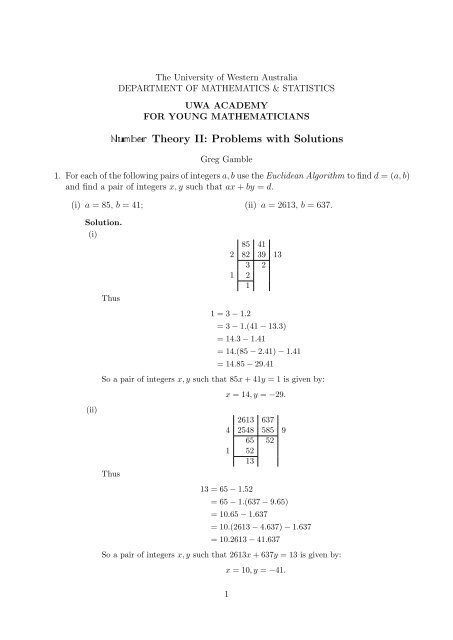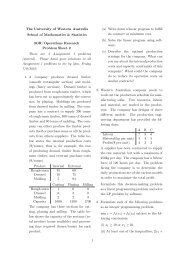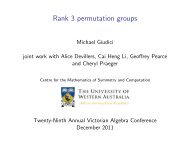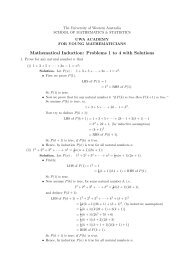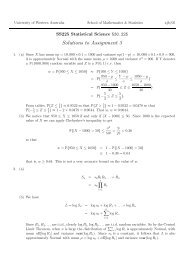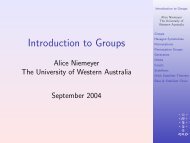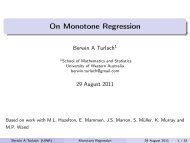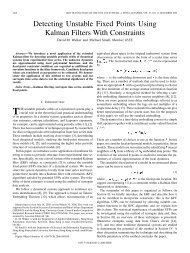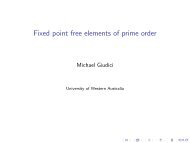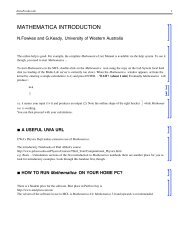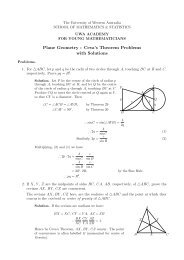Number Theory II: Problems with Solutions - The University of ...
Number Theory II: Problems with Solutions - The University of ...
Number Theory II: Problems with Solutions - The University of ...
You also want an ePaper? Increase the reach of your titles
YUMPU automatically turns print PDFs into web optimized ePapers that Google loves.
<strong>The</strong> <strong>University</strong> <strong>of</strong> Western AustraliaDEPARTMENT OF MATHEMATICS & STATISTICSUWA ACADEMYFOR YOUNG MATHEMATICIANS<strong>Number</strong> <strong><strong>The</strong>ory</strong> <strong>II</strong>: <strong>Problems</strong> <strong>with</strong> <strong>Solutions</strong>Greg Gamble1. For each <strong>of</strong> the following pairs <strong>of</strong> integers a, b use the Euclidean Algorithm to find d = (a, b)and find a pair <strong>of</strong> integers x, y such that ax + by = d.(i) a = 85, b = 41; (ii) a = 2613, b = 637.Solution.(i)Thus85 412 82 39 133 21 211 = 3 − 1.2= 3 − 1.(41 − 13.3)= 14.3 − 1.41= 14.(85 − 2.41) − 1.41= 14.85 − 29.41So a pair <strong>of</strong> integers x, y such that 85x + 41y = 1 is given by:x = 14, y = −29.(ii)Thus2613 6374 2548 585 965 521 521313 = 65 − 1.52= 65 − 1.(637 − 9.65)= 10.65 − 1.637= 10.(2613 − 4.637) − 1.637= 10.2613 − 41.637So a pair <strong>of</strong> integers x, y such that 2613x + 637y = 13 is given by:x = 10, y = −41.1
2. Show that if there exist integers x, y such that ax + by = 1 then (a, b) = 1.Solution. Let d = (a, b). <strong>The</strong>n, by Property 1, d ax + by. But ax + by = 1. So d 1, i.e.d ≤ 1. <strong>The</strong> gcd is necessarily ≥ 1. Hence d = 1.3. Show that (3k + 2, 5k + 3) = 1 for any integer k.Solution.(3k + 2, 5k + 3) = (3k + 2, 2k + 1) since 2k + 1 = 5k + 3 − (3k + 2)= (k + 1, 2k + 1) since k + 1 = 3k + 2 − (2k + 1)= (k + 1, k) since k = 2k + 1 − (k + 1)= (1, k) since 1 = k + 1 − k= 1Observe that this is just the Euclidean Algorithm applied to algebraic expressions ratherthan integers.4. Show that (a, a + 2) = 2 if a is even and (a, a + 2) = 1 otherwise.Solution. Since 2 = a + 2 − a, we have(a, a + 2) = (a, 2){2 if 2 a=1 otherwise5. Show that if (a, b) = 1 then (a + b, a − b) = 1 or 2.Solution. Let d = (a+b, a−b). <strong>The</strong>n d 2a = (a+b)+(a−b) and d 2b = (a+b)−(a−b).Henced (2a, 2b) = 2(a, b) = 2.That is, d = (a + b, a − b) is either 1 or 2.6. Find all solutions to the following Diophantine Equations.(i) 2x + 5y = 11. (ii) 12x + 18y = 50. (iii) 202x + 74y = 7638.Does equation (iii) have a solution in positive integers x, y?Solution.(i) Here (2, 5) = 1, and since 2.3 + 5.1 = 11 we have the general solutionx = 3 + 5ty = 1 − 2t(This one can be done <strong>with</strong>out using the Euclidean Algorithm since the solution isalmost obvious.)(ii) Here (12, 18) = 6. So 6 12x + 18y. But 6̸ 50. Hence there is no solution.2
(iii) <strong>The</strong> problem is equivalent to that <strong>of</strong> finding solutions <strong>of</strong> 101x+37y = 3819 (eliminatingthe common factor: 2). Applying the Euclidean Algorithm to 101 and 37 we have:ThusSo, by the theorem we have101 372 74 27 127 102 20 7 17 32 611 = 7 − 2.3= 7 − 2.(10 − 1.7)= 3.7 − 2.10= 3.(27 − 2.10) − 2.10= 3.27 − 8.10= 3.27 − 8.(37 − 1.27)= 11.27 − 8.37= 11.(101 − 2.37) − 8.37= 11.101 − 30.37x = 11.3819 + 37ty = −30.3819 − 101tas the general solution.(Alternatively) We could instead make the following observations:giving the following general solution3700 = 100.37101 = 1.10118 = (18.11).101 + (18.−30).37So . . . 3819 = 199.101 + −440.37x = 199 + 37sy = −440 − 101swhere s ∈ Z. <strong>The</strong> advantage <strong>of</strong> the second approach is that it yields a much smallerstarter solution, making it that much easier to determine whether x, y can both bepositive. We see that for y to be positive s ≤ −5, and for x to be positive s ≥ −5.Thus, if s = −5, both x and y are positive, and the solution in this case is:x = 14 and y = 65,and this is the unique solution <strong>with</strong> this property.3
7. A grocer orders apples and oranges at a total cost <strong>of</strong> $8.39. If apples cost 25c each andoranges cost 18c each, how many <strong>of</strong> each type <strong>of</strong> fruit did the grocer order?Solution. Let x be the number <strong>of</strong> apples and y be the number <strong>of</strong> oranges. <strong>The</strong>n25x + 18y = 839.Applying a slight modification <strong>of</strong> the Euclidean Algorithm to 25 and 18 we have25 181 18 14 27 42 8−1Observe we allowed a ‘negative remainder’ at the last step. Sometimes doing this shortcutsa bit <strong>of</strong> work . . . essentially the Euclidean Algorithm still works if we do this. SoObserve thatgiving the following general solution−1 = 7 − 2.4= 7 − 2.(18 − 2.7)= 5.7 − 2.18= 5.(25 − 1.18) − 2.18= 5.25 − 7.18Hence . . . 1 = −5.25 + 7.18800 = 32.2536 = 2.183 = (−5.3).25 + (7.3).18So . . . 839 = 17.25 + 23.18x = 17 + 18ty = 23 − 25twhere t ∈ Z. Since x, y are both positive, we must have t = 0. So there are 17 apples and23 oranges.8. An apartment block has units at two rates: most rent at $87/week, but a few rent at$123/week. When all are rented the gross income is $8733/week. How many units <strong>of</strong> eachtype are there?Solution. Let x, y be the numbers <strong>of</strong> apartments at the rates $87/week and $123/week,respectively. <strong>The</strong>n87x + 123y = 8733.Cancelling the common factor 3 we have29x + 41y = 2911.4
Applying the Euclidean Algorithm to 29 and 41 we haveSo29 412 24 29 15 122 4 10 21 21 = 5 − 2.2= 5 − 2.(12 − 2.5)= 5.5 − 2.12= 5.(29 − 2.12) − 2.12= 5.29 − 12.12= 5.29 − 12.(41 − 1.29)= 17.29 − 12.41Observe that2900 = 100.2912 = −1.29 + 1.41−1 = −17.29 + 12.41So . . . 2911 = 82.29 + 13.41giving the following general solutionx = 82 + 41ty = 13 − 29twhere t ∈ Z. Since x, y are both positive, we must have t = 0 or t = −1. If t = −1 thenx = 41 < 42 = y, in which case there are more <strong>of</strong> the $123/week apartments (contrary tothe given information). So t = 0 and there are 82 apartments renting at $87/week and 13apartments renting at $123/week.∗9. Find all integers x, y satisfying:1x + 1 y = 1 14 .Solution. First let us multiply both sides <strong>of</strong> the given equation by xy. This gives:y + x = xy14Since x, y ∈ Z we must have 14 xy and hence 7 xy whence 7 x or 7 y. Without loss <strong>of</strong>generality assume 7 x, and write x = 7k. <strong>The</strong>nand we have 2 ky and hence 2 k or 2 y.Case 1: 2 k. Write k = 2l, so thaty + 7k = ky2y + 14l = ly.5
Since l 14l and l ly we have l y. Hence y = lm, say and som + 14 = lmand we have that m 14 (i.e. m ∈ {±1, ±2, ±7, ±14}) and l = 1 + 14/m, giving:x = 14(1 + 14/m)y = m(1 + 14/m).Furthermore, since x, y are non-zero, m ≠ −14. Enumerating the possibilities for thepairs (x, y) we get(210, 15), (−182, 13), (112, 16), (−84, 12), (42, 21), (−14, 7), (28, 28).Case 2: 2̸ k and 2 y. Write y = 2s, so that2s + 7k = ks.Since k 7k and k ks, but 2̸ k we must have k s. Write s = kt. <strong>The</strong>n2t + 7 = ktand we have that t 7 (i.e. t ∈ {±1, ±7}) and k = 2 + 7/t, giving:x = 7(2 + 7/t)y = 2(2 + 7/t)t.Like the previous case, since x, y are non-zero, t ≠ −7. Enumerating the possibilitiesfor the pairs (x, y) we get(63, 18), (−35, 10), (21, 42).We found the pair (21, 42) (in the reverse order) in Case 1.Thus the complete list <strong>of</strong> pairs for (x, y) is(210, 15), (−182, 13), (112, 16), (−84, 12), (42, 21), (−14, 7), (28, 28), (63, 18), (−35, 10),or <strong>of</strong> course the same pairs in reverse order.∗10. When Jane is one year younger than Betty will be when Jane is half as old as Betty willbe when Jane is twice as old as Betty is now, Betty will be three times as old as Janewas when Betty was as old as Jane is now.One is in her teens and ages are in completed years. How old are they?Solution. Let Jane’s age now be x and Betty’s age now be y. Also, we will representthe ages <strong>of</strong> Jane and Betty at time i by x i and y i respectively. Let’s rewrite the giveninformation, including these choices <strong>of</strong> variables.When Jane [is x 1 , she] is one year younger than Betty will be [when she is y 2and] when Jane [is x 2 and she] is half as old as Betty will be [when she is y 3and] when Jane [is x 3 and she] is twice as old as Betty is now [when she isy], Betty will be [y 1 and she will be] three times as old as Jane was when [shewas x 4 and when] Betty was [y 4 and she was] as old as Jane is now [when she is x].6
So we get the following equations:x 1 = y 2 − 1x 2 = 1 2 y 3x 3 = 2yy 1 = 3x 4y 4 = x.Now define a, b, c, d such that x 1 = x + a, x 2 = x + b, x 3 = x + c, x 4 = x + d; so thaty 1 = y + a, y 2 = y + b, y 3 = y + c, y 4 = y + d. Hence the above equations become:x + a = y + b − 1x + b = 1 2(y + c)x + c = 2yy + a = 3(x + d)y + d = x.Now rearrange these equations (and multiply by a factor where appropriate):x + a − b = y − 1x + b − 1 2 c = 1 2 y12 x + 1 2 c = y3x − a + 3d = y3x − 3d = 3y.Adding these equations we find that a, b, c, d cancel and we get:8 1 2 x = 6 1 2 y − 1i.e.13y − 17x = 2. (1)Since x, y are only allowed to be integers, this equation is an example <strong>of</strong> a linear DiophantineEquation. A method for solving such an equation is to first apply the EuclideanAlgorithm to find the gcd d <strong>of</strong> 13 and 17 (which is clearly 1). Tracing the algorithm backwardsone can express d in terms <strong>of</strong> 13 and 17. Applying the Euclidean Algorithm then(see Notes) we get:13 173 12 13 11 4Thus1 = 13 − 12= 13 − 3.4= 13 − 3.(17 − 13)= 4.13 − 3.17.7
So2 = 8.13 − 6.17= 8.13 + 13.17t − 13.17t − 6.17= 13(8 + 17t) − 17(6 + 13t).Comparing the above <strong>with</strong> (1) we see that we have a solution for (1) ifx = 6 + 13ty = 8 + 17tfor some integer t, which by the theorem in the notes is the general solution. We were alsogiven that one girl was in her teens, so that t must be 1 andHence Jane is 19 and Betty is 25.x = 19, y = 25.11. Solve the adjacent alphametic (an additionin which: each letter stands for a differentdigit; and left-most digits <strong>of</strong> a number arenot allowed to be 0).A H AA H AAW A GH A H ASolution.• First let the carry from the right column be k then it is easy to see that2A + G = 10k (2)H + A + k = 10 (3)A + W + 1 = 10 (4)H = 1 (5)• Now k is either 1 or 2 (considering the least and largest values possible for A and G. . . remembering that 2A + G is exactly a multiple <strong>of</strong> 10.)• Since H = 1 and k ∈ {1, 2}, it follows from (3) that A is 8 or 7.• If A = 8 then by (4) W = 1, in which case H and W are equal (which is not allowed).So A ≠ 8. Hence A = 7 . <strong>The</strong>refore k = 2 and G = 6 , and by (4) W = 2 .• So finally we get (and check)• So HAHA = 1717.7 1 77 1 772 7 61 7 1 78
12. About all we know <strong>of</strong> Diophantus’ life is his epitaph from which his age at death is to bededuced:Diophantus spent one-sixth <strong>of</strong> his life in childhood, one-twelfth in youth, andanother one-seventh in bachelorhood. A son was born five years after his marriageand died four years before his father at half his father’s age.Solution. Let x be Diophantus’ age at death. <strong>The</strong>nRearranging, we getx − 4 − ( ( 1 6 + 112 + 1 7 )x + 5) = 1 2 x.( 12 − ( 1 6 + 112 + 1 7 )) x = 9328 x = 9Hence, x = 9. 28 3= 84. Diophantus died at the age <strong>of</strong> 84.13. Augustus de Morgan, a nineteenth-century mathematician, stated:I was x years old in the year x 2 .When was he born?Solution. Since 42 2 = 1764, 43 2 = 1849 and 44 2 = 1936, x = 43 and x 2 = 1849. SoAugustus de Morgan was born in 1806.14. Prove that for every integer n:(i) 3 n 3 − n;(ii) 5 n 5 − n;(iii) 7 n 7 − n;(iv) 11 n 11 − n.Show that n 9 − n is not necessarily divisible by 9. Hint: Try n = 2.What general result is suggested by the above?Solution.(i) 3 divides exactly one <strong>of</strong> the three consecutive integers n − 1, n, n + 1 andSo 3 n 3 − n.n 3 − n = n(n 2 − 1) = n(n − 1)(n + 1).(ii) 5 divides exactly one <strong>of</strong> the five consecutive integers n − 2, n − 1, n, n + 1, n + 2. Interms <strong>of</strong> congruences, exactly one <strong>of</strong> n − 2, n − 1, n, n + 1, n + 2 is congruent to 0modulo 5. Thus:n 5 − n = n(n 4 − 1) = n(n 2 − 1)(n 2 + 1) = n(n − 1)(n + 1)(n 2 + 1)So 5 n 5 − n.≡ n(n − 1)(n + 1)(n 2 − 4) (mod 5)≡ n(n − 1)(n + 1)(n − 2)(n + 2) (mod 5)≡ 0 (mod 5)9
(iii) Exactly one <strong>of</strong> n − 3, n − 2, n − 1, n, n + 1, n + 2, n + 3 is congruent to 0 modulo 7.Thus:n 7 − n = n(n 6 − 1) = n(n 3 − 1)(n 3 + 1)= n(n − 1)(n 2 + n + 1)(n + 1)(n 2 − n + 1)≡ n(n − 1)(n 2 + n − 6)(n + 1)(n 2 − n − 6) (mod 7)≡ n(n − 1)(n + 3)(n − 2)(n + 1)(n − 3)(n + 2) (mod 7)≡ 0 (mod 7)So 7 n 7 − n.(iv) n is congruent to exactly one <strong>of</strong> −5, −4, −3, −2, −1, 0, 1, 2, 3, 4, 5 modulo 11. It issimply a matter <strong>of</strong> checking, for each congruence possibility <strong>of</strong> n, that n 11 − n (or afactor <strong>of</strong> n 11 − n) is congruent to 0 modulo 11. Note, first that:n 11 − n = n(n 10 − 1).• If n ≡ 0 (mod 11) there is nothing to check since n is a factor <strong>of</strong> n 11 − n.• (−1) 10 − 1 ≡ 1 10 − 1 ≡ 0 (mod 11).So n 10 − 1 ≡ 0 (mod 11) if n ≡ ±1 (mod 11).• 2 5 = 32 ≡ −1 (mod 11). So 2 10 = (2 5 ) 2 ≡ 1 (mod 11).Hence (−2) 10 − 1 ≡ 2 10 − 1 ≡ 0 (mod 11).So n 10 − 1 ≡ 0 (mod 11) if n ≡ ±2 (mod 11).• 3 5 = 243 ≡ 1 (mod 11). So 3 10 = (3 5 ) 2 ≡ 1 (mod 11).Hence (−3) 10 − 1 ≡ 3 10 − 1 ≡ 0 (mod 11).So n 10 − 1 ≡ 0 (mod 11) if n ≡ ±3 (mod 11).• 2 5 = 32 ≡ −1 (mod 11). So 4 10 = (2 5 ) 4 ≡ 1 (mod 11).Hence (−4) 10 − 1 ≡ 4 10 − 1 ≡ 0 (mod 11).So n 10 − 1 ≡ 0 (mod 11) if n ≡ ±4 (mod 11).• 5 2 = 25 ≡ 4 (mod 11) and 4 5 = (2 5 ) 2 ≡ 1 (mod 11).So 5 10 = (5 2 ) 5 ≡ 4 5 ≡ 1 (mod 11). Hence (−5) 10 − 1 ≡ 5 10 − 1 ≡ 0 (mod 11).So n 10 − 1 ≡ 0 (mod 11) if n ≡ ±5 (mod 11).So, for each congruence possibility <strong>of</strong> n, we find a factor <strong>of</strong> n 11 − n is congruent to0 modulo 11. So for any integer n, n 11 − n ≡ 0 (mod 11). Hence for any integern n 11 − n.Now 2 9 − 2 = 510 and 9̸ 510; so 9 need not divide n 9 − n. <strong>The</strong> general result suggestedby the above is the Corollary to Fermat’s Little <strong>The</strong>orem, which may be written in thefollowing way:If n is an integer and p is a prime then p n p − n.15. Prove that 3 6n − 2 6n is divisible by 35, for every positive integer n.Solution. Let N = 3 6n − 2 6n . Now 35 = lcm(5, 7). So to check that 35 N, it is enoughto show that 5 N and 7 N.• Firstly,and hence 5 N.N = 3 6n − 2 6n = 9 3n − 4 3n≡ 4 3n − 4 3n (mod 5)≡ 0 (mod 5),10
• Similarly,N = 3 6n − 2 6n = 27 2n − 8 2n≡ (−1) 2n − 1 2n (mod 7)≡ 1 n − 1 n (mod 7)≡ 0 (mod 7),and hence 7 N.Thus, since 5 N and 7 N, we have 35 = lcm(5, 7) divides N = 3 6n − 2 6n .∗16. What is the final digit <strong>of</strong> 7 777777 .Solution. Firstly, we will call an expression <strong>of</strong> the form7 777...7a tower <strong>of</strong> 7s. Our problem has a tower <strong>of</strong> 7 7s. Observe thatHence, modulo 10,7 4 = (7 2 ) 2 ≡ (−1) 2 ≡ 1 (mod 10).⎧1 if k ≡ 0 (mod 4)⎪⎨7 k 7 if k ≡ 1 (mod 4)≡−1 if k ≡ 2 (mod 4)⎪⎩−7 if k ≡ 3 (mod 4),where k is a natural number. Thus to determine the last digit <strong>of</strong> a tower <strong>of</strong> 7 7s, we needto determine what a tower <strong>of</strong> 6 7s is congruent to modulo 4. Now, 7 ≡ −1 (mod 4). Hence,modulo 4,{7 m 1 if m is even≡−1 if m is odd,where m is a natural number. A tower <strong>of</strong> 5 7s is certainly odd. So, a tower <strong>of</strong> 6 7s iscongruent to −1 modulo 4 (and −1 ≡ 3 (mod 4) ). So, a tower <strong>of</strong> 7 7s is congruent to −7modulo 10 (and −7 ≡ 3 (mod 10) ). Hence, a tower <strong>of</strong> 7 7s must end in a 3.17. Prove that for any natural number n thatSolution.17 divides 2 n .3 2n − 1.2 n .3 2n − 1 = (2.3 2 ) n − 1= 18 n − 1≡ 1 n − 1 (mod 17)≡ 0 (mod 17).So 17 2 n .3 2n − 1. (Remember: N ≡ 0 (mod m) means exactly the same thing as m N.)11
18. Prove that for any natural number nis divisible by 35.17 n − 12 n − 24 n + 19 nSolution. Let N = 17 n − 12 n − 24 n + 19 n . Now 35 = lcm(5, 7). So to check that 35 N,it is enough to show that 5 N and 7 N.• Firstly,and hence 5 N.• Similarly,and hence 7 N.N = 17 n − 12 n − 24 n + 19 n≡ 2 n − 2 n − 4 n + 4 n (mod 5)≡ 0 (mod 5),N = 17 n − 12 n − 24 n + 19 n≡ 3 n − 5 n − 3 n + 5 n (mod 7)≡ 0 (mod 7),Thus, since 5 N and 7 N, we have 35 = lcm(5, 7) divides N = 17 n − 12 n − 24 n + 19 n .∗19. Prove that 5 99 + 11 99 + 17 99 is divisible by 33.Solution. Let N = 5 99 + 11 99 + 17 99 . Now 33 = lcm(3, 11). So to check that 33 N, it isenough to show that 3 N and 11 N. Again, we shall use congruences.• Firstly,and hence 3 N.• Similarly,and hence 11 N.N = 5 99 + 11 99 + 17 99≡ 2 99 + 2 99 + 2 99 (mod 3)≡ 3.2 99 (mod 3)≡ 0 (mod 3),N = 5 99 + 11 99 + 17 99≡ 5 99 + 0 99 + (−5) 99 (mod 11)≡ 5 99 + 0 − 5 99 (mod 11)≡ 0 (mod 11),Thus, since 3 N and 11 N, we have 33 = lcm(3, 11) divides N = 5 99 + 11 99 + 17 99 .12
∗20. What is the final digit <strong>of</strong> ((((((((((7 7 ) 7 ) 7 ) 7 ) 7 ) 7 ) 7 ) 7 ) 7 ) 7 )? (7 occurs as a power 10 times.)Solution. <strong>The</strong> final digit <strong>of</strong> a (decimal) number is its remainder modulo 10. Now 7 2 =49 ≡ −1 (mod 10). So 7 7 = (7 2 ) 3 .7 ≡ −7 (mod 10), and(7 7 ) 7 ≡ (−7) 7 ≡ −(7 7 ) ≡ −(−7) ≡ 7 (mod 10).Proceeding in this way, we see that ((7 7 ) 7 ) 7 ≡ 7 (mod 10), and in general(· · · (((7 7 ) 7 ) 7 ) · · ·7)≡ ±7 (mod 10),where the sign is + if all together there is an even number <strong>of</strong> 7s appearing as powers inthe formula, and − if there is an odd number <strong>of</strong> 7s appearing as powers in the formula.Now, 10 is even. So the final digit <strong>of</strong> the given formula is 7.∗21. (17th International Olympiad, 1975, Problem 4) When 4444 4444 is written in decimalnotation, the sum <strong>of</strong> its digits is A. Let B be the sum <strong>of</strong> the digits <strong>of</strong> A. Find the sum<strong>of</strong> the digits <strong>of</strong> B.Hints: First show that the sum <strong>of</strong> the digits <strong>of</strong> B is fairly small (in fact: less than 16).<strong>The</strong>n use the fact that, for any natural number N,Solution.N ≡ (sum <strong>of</strong> the digits <strong>of</strong> N) (mod 9).• First we will show that the sum <strong>of</strong> the digits <strong>of</strong> B is fairly small. Now 4444 < 10 000 =10 4 . Hence4444 4444 < 10 4.4444 = 10 17776 ,and so 4444 4444 cannot have more than 17 776 digits. Thus, A the sum <strong>of</strong> the digits<strong>of</strong> 4444 4444 , cannot be more than 17 776.9 = 159 984, (since each digit is at most a9). Of the natural numbers less than or equal to 159 984, the number <strong>with</strong> the largestdigit sum is 99 999. So B is not more than 45. Of the natural numbers less than orequal to 45, the number <strong>with</strong> the largest digit sum is 39. So the sum <strong>of</strong> the digits <strong>of</strong>B is not more than 12.• Now we use the result given in the hint:For any natural number N, N ≡ (sum <strong>of</strong> the digits <strong>of</strong> N) (mod 9).(Note that this result was proved when we proved the divisibility rule for 9.) Usingthis result we see that 4444 4444 is congruent to its digit sum A, modulo 9. Using theresult again, we see that A is congruent to its digit sum B, modulo 9. Using the resultone further time, we see that B is congruent to its digit sum, modulo 9. That is,4444 4444 ≡ A (mod 9)≡ B (mod 9)≡ (sum <strong>of</strong> the digits <strong>of</strong> B) (mod 9)13
• Now we determine what 4444 4444 is congruent to modulo 9.4444 4444 ≡ (4 + 4 + 4 + 4) 4444 (mod 9)≡ 16 4444 (mod 9)≡ (−2) 4444 (mod 9)≡ (−2) 3.1481+1 (mod 9)≡ ( (−2) 3) 1481 .(−2) (mod 9)≡ (−8) 1481 .(−2) (mod 9)≡ 1 1481 .(−2) (mod 9)≡ 1.(−2) (mod 9)≡ 7 (mod 9)Putting these three facts together we get(the sum <strong>of</strong> the digits <strong>of</strong> B) ≡ 7 (mod 9)and the sum <strong>of</strong> the digits <strong>of</strong> B is a natural number less than or equal to 12. Thus(the sum <strong>of</strong> the digits <strong>of</strong> B) = 7.14


